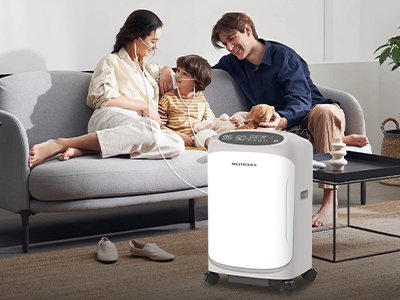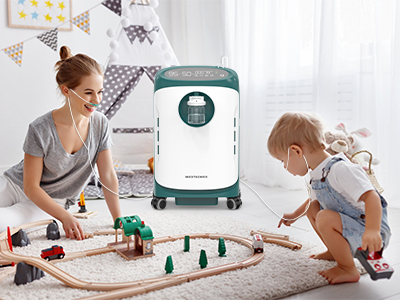23 Oct 2024
Ensuring safety while using oxygen at home is paramount for both patients and caregivers.Oxygen is a life-saving resource for many individuals with respiratory issues, yet it comes with inherent risks if not handled correctly. Understanding and implementing safety measures can significantly mitigate these dangers, enhancing the efficacy of oxygen therapy and protecting everyone in the home. Below are ten essential tips to maintain a safe environment for oxygen use.

Tip 1: Maintain a Safe Distance from Flames
One of the most critical safety measures is to keep oxygen supplies away from open flames. Oxygen itself is not flammable, but it accelerates combustion. Even a small spark can ignite materials in an oxygen-rich environment. Therefore, maintain a safe distance of at least 10 feet from sources of ignition, including candles, gas stoves, and fireplaces. Implementing strict no-flame policies in the vicinity of oxygen use is essential for safeguarding everyone in the home.
Tip 2: Store Oxygen Cylinders Properly
Proper storage of oxygen cylinders is crucial for preventing accidents. Store cylinders in a cool, dry place, upright and secured to prevent tipping. It is advisable to keep them in designated storage areas away from heat sources and direct sunlight. Always ensure that the valve is closed when not in use, and never allow them to roll freely. Secure storage minimizes the risk of damage and ensures a safer environment.

Tip 3: Regularly Inspect Equipment
Routine inspections of oxygen equipment are vital to ensure functionality and safety. Check for any signs of wear, leaks, or damage, including cracks in tubing and deterioration of masks. Regularly assess the pressure gauge on cylinders to ensure adequate oxygen supply. Keeping a maintenance log can help track these inspections and identify potential issues before they escalate.
Tip 4: Use Oxygen Devices as Prescribed
Using oxygen equipment as directed by healthcare professionals is critical for safety and effectiveness. Follow prescribed settings for flow rates and duration to avoid complications. Misusing oxygen therapy can lead to adverse effects, such as oxygen toxicity or insufficient oxygenation. Always consult with healthcare providers if there are any uncertainties regarding usage.
Tip 5: Keep Your Environment Well-Ventilated
Proper ventilation plays a significant role in maintaining safety when using oxygen. Ensure that rooms where oxygen is used are well-ventilated to reduce the accumulation of any potentially harmful gases. Opening windows or using fans can help facilitate airflow, ensuring that oxygen use does not create a suffocating environment. Good ventilation enhances comfort and safety for both patients and caregivers.
Tip 6: Avoid Smoking and Open Flames
The prohibition of smoking near oxygen use cannot be overstated. Tobacco smoke poses a serious risk in an oxygen-rich environment, and the same applies to other combustible materials. Encourage a smoke-free home policy and remind visitors of the importance of avoiding open flames or anything that could ignite in proximity to oxygen. This vigilance is crucial for preventing fire hazards.
Tip 7: Educate Family Members
Everyone in the household should be informed about the potential hazards associated with oxygen use. Conduct educational sessions on safe practices, emergency protocols, and how to handle oxygen equipment. Ensure that family members are aware of the signs of a malfunction and know how to respond in case of an emergency. Knowledge is a powerful tool for enhancing safety.
Tip 8: Have a Fire Extinguisher Accessible
Keeping a fire extinguisher nearby is an essential safety measure when using oxygen at home. Ensure that it is appropriate for the types of fires that could occur, such as Class B (flammable liquids) and Class C (electrical fires). Regularly check the extinguisher to ensure it is charged and easily accessible. Familiarize yourself and your family members with its use, as preparedness can be vital in an emergency.
Tip 9: Understand Emergency Protocols
In the event of a fire or equipment failure, knowing the correct emergency protocols can make all the difference. Develop a clear plan of action for various scenarios, including evacuation routes and contact numbers for emergency services. Understanding when to seek immediate help and how to respond to an oxygen-related emergency is critical for safety. Regular drills can reinforce this knowledge.
Tip 10: Consult with Healthcare Professionals
Regular communication with healthcare providers can significantly enhance safety regarding oxygen therapy. Schedule routine check-ups to discuss any concerns or changes in health status. Healthcare professionals can provide guidance on the best practices for home oxygen use and help troubleshoot any issues with equipment. Their expertise is invaluable in ensuring both safety and effectiveness.
Conclusion
Maintaining safety while using oxygen at home is a shared responsibility that requires awareness and proactive measures. Vigilance, education, and preparedness are key components in fostering a safe home for oxygen use, ultimately enhancing the quality of life for those who depend on this essential therapy.
Keywords: oxygen
Originally published 23 Oct 2024, updated 23 Oct 2024.